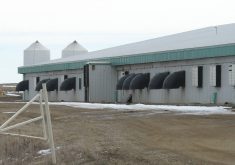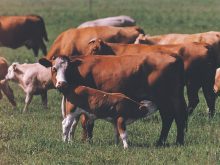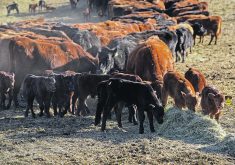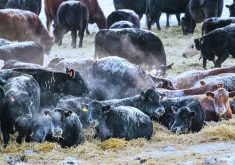Pregnancy toxemia strikes cows, especially overly fat ones, during the last two months of pregnancy.
This metabolic condition is caused by improper feeding. Cows with unlimited access to spring and summer pastures can gain so much weight that their body condition scores rise: up to seven or more on a nine-point scale.
When pasture or feed quality subsequently declines in the winter and nutritional needs increase at the end of pregnancy, these overly fat animals are at high risk for developing what’s called preg tox.
Read Also

Rest stops of no benefit to feeder calves during long hauls, according to researchers
Three Canadian transport trials showed that providing a rest stop during long-distance transport provided no clear or consistent benefits for the health or welfare of feeder calves.
Pregnancy toxemia occurs more commonly in cows bearing twins and can be experimentally induced by starving overfat pregnant cows for as little as two days.
Lethargy and depression are the first symptoms. Next, the cows stop foraging and separate themselves from the herd. In most cases, only a few cows, usually the extremely fat ones, will exhibit clinical signs, but because the entire herd is stressed by poor nutrition, this is just the tip of the iceberg. Many more are subclinically affected.
If you are observant and have a good nose, you may be able to smell the sweet odour of acetone on the breath of an affected cow. It is a ketone that is a byproduct of the breakdown of fat. If ketones are detectable, the cow is not obtaining enough calories to keep up with its energy demands so it has to start breaking down its fat stores.
As the condition progresses, cows start to breathe faster and then they develop a forced expiratory grunt. They pass sparse amounts of dry manure that is often covered with mucous and sometimes contains blood.
Pregnancy toxemia spirals quickly downhill as cows go completely off their feed. They eventually become recumbent. Without treatment, they die within three to 14 days.
Cows that are struck by preg tox during the final days of pregnancy may demonstrate completely different signs. For some unknown reason, the metabolic abnormalities of preg tox at this stage of pregnancy cause symptoms in the nervous system. Cows become excitable and have an unco-ordinated, high-stepping gait. The typical symptoms then develop – they become depressed, recumbent and are unable to rise. Eventually they stop eating. Some cows die during parturition while others linger, dying within 30 days of calving.
Pregnancy toxemia should be suspected when cows in late gestation exhibit the characteristic symptoms. A blood test that measures ketones can be a useful tool for confirming the disease. A urine test for ketones can also be used.
Cows that are severely affected with ketosis have a poor prognosis and usually die despite treatment. Treatment is only worthwhile in mild cases of preg tox. It starts by giving an energy boost with an intravenous injection of glucose. This provides an immediate benefit, but repeated injections are needed to maintain blood sugar levels and that would be impractical.
As a follow-up, cows are given propylene glycol orally, which supplies glucose precursors that can meet the cow’s calorie needs. Anabolic steroids, the same hormones bodybuilders use, can stimulate appetite and boost metabolism.
Part of the reason a cow becomes deficient in energy in late gestation is the tremendous energy drawn by its rapidly developing calf. Removal of the calf by caesarean may be economically viable in a valuable animal.
As soon as a single case of pregnancy toxemia has been confirmed, the nutrition of the entire herd must be boosted by offering supplemental feed or good quality hay. Cows that seem to be at immediate risk because they aren’t eating can be given propylene glycol as a preventive measure.
Pregnancy toxemia is prevented by feeding cows properly. Cows should not be allowed to gain too much weight before winter feeding. They should not enter the last months of pregnancy in overly fat condition. Also, pregnant cows should not be allowed to lose a lot of weight near the end of pregnancy. If they do, they need supplemental feed.














